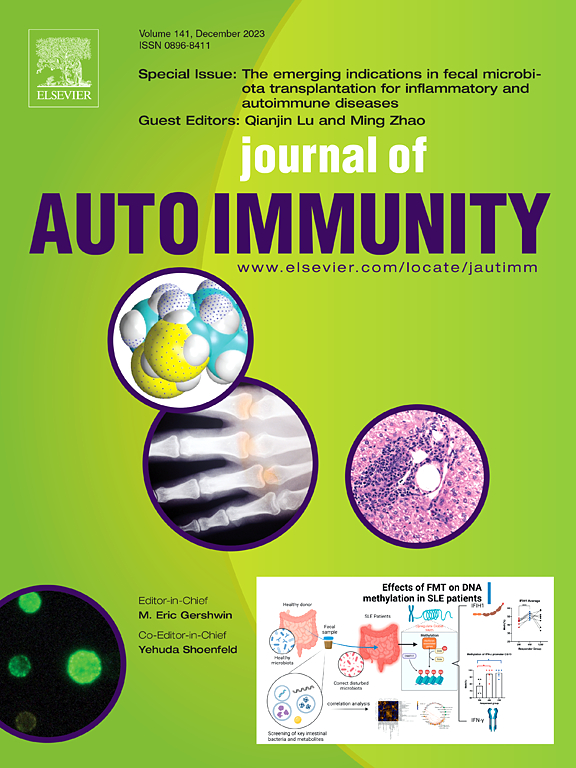Anti-retinal immune response in sarcoid uveitis: A potential role for PCLO as an antigenic target
IF 7
1区 医学
Q1 IMMUNOLOGY
引用次数: 0
Abstract
Purpose
To explore the autoimmune component of sarcoid uveitis (SU) by analyzing serum anti-retinal antibodies (ARAs), identifying targeted retinal proteins, T- and B-cell receptor repertoires and HLA genotype.
Methods
Material from 45 sarcoidosis patients with no presenting uveitis (SNPU) and 46 with SU was analyzed. Serum ARAs and targeted retinal layers were assessed using indirect immunofluorescence staining. HuScan analysis identified autoantibody-targeted linear epitopes. Validation included a bead-based assay for anti-Piccolo Presynaptic Cytomatrix Protein (PCLO) antibodies and an ELISpot assay for PCLO-reactive T-lymphocytes. T cell receptor beta (TCRB) and B cell receptor heavy (BCRH) repertoire analyses were performed using next-generation sequencing and HLA class II genotypes were determined by sequence-specific primer analysis.
Results
ARAs were more prevalent in SU patients than in SNPU patients (52 vs. 22 %, p = 0.003), with significant more reactivity against the nuclear retinal layer (32 vs. 7 %, p = 0.005). HuScan identified autoantibodies against three retinal proteins, including PCLO. Bead-based analysis showed higher anti-PCLO autoantibody levels in ARA-positive patients (median: 913.3 vs. 544.5, p = 0.035), and PCLO-directed T-lymphocytes were present in ARA-positive SU patients. Two TCRB clusters were identified in four unique ARA positive patients, while absent in ARA negative patients. No HLA allele association with ARA status could be detected.
Conclusion
Our findings reveal an association between serum ARA-positivity and SU, suggesting a link to autoimmune processes. An humoral and cellular response against the retinal protein PCLO was identified, highlighting PCLO as a potential autoimmune target in ARA-positive patients. Additionally, specific TCRB clusters were found to correlate with ARA status.
结节性葡萄膜炎的抗视网膜免疫反应:PCLO作为抗原靶点的潜在作用。
目的:通过分析血清抗视网膜抗体(ARAs)、鉴定视网膜靶蛋白、T细胞和b细胞受体谱及HLA基因型,探讨肉瘤样葡萄膜炎(SU)的自身免疫成分。方法:对45例无首发葡萄膜炎(SNPU)结节病患者和46例伴有葡萄膜炎(SU)结节病患者的资料进行分析。采用间接免疫荧光染色法测定血清ARAs和靶向视网膜层。HuScan分析确定了自身抗体靶向的线性表位。验证包括抗短笛突触前细胞基质蛋白(PCLO)抗体的头部检测和PCLO反应性t淋巴细胞的ELISpot检测。采用新一代测序技术进行T细胞受体(TCRB)和B细胞受体重(BCRH)全库分析,通过序列特异性引物分析确定HLAⅱ类基因型。结果:as在SU患者中比在SNPU患者中更普遍(52%比22%,p = 0.003),对视网膜核层的反应性更明显(32%比7%,p = 0.005)。HuScan鉴定出针对三种视网膜蛋白的自身抗体,包括PCLO。基于珠球的分析显示,ara阳性患者的抗pclo自身抗体水平较高(中位数:913.3比544.5,p = 0.035), ara阳性SU患者存在pclo定向t淋巴细胞。在4例独特的ARA阳性患者中发现了2个TCRB集群,而在ARA阴性患者中没有发现。未发现与ARA状态相关的HLA等位基因。结论:我们的研究结果揭示了血清ara阳性与SU之间的关联,提示其与自身免疫过程有关。发现了针对视网膜蛋白PCLO的体液和细胞反应,强调PCLO是ara阳性患者的潜在自身免疫靶标。此外,发现特定的TCRB集群与ARA状态相关。
本文章由计算机程序翻译,如有差异,请以英文原文为准。
求助全文
约1分钟内获得全文
求助全文
来源期刊

Journal of autoimmunity
医学-免疫学
CiteScore
27.90
自引率
1.60%
发文量
117
审稿时长
17 days
期刊介绍:
The Journal of Autoimmunity serves as the primary publication for research on various facets of autoimmunity. These include topics such as the mechanism of self-recognition, regulation of autoimmune responses, experimental autoimmune diseases, diagnostic tests for autoantibodies, as well as the epidemiology, pathophysiology, and treatment of autoimmune diseases. While the journal covers a wide range of subjects, it emphasizes papers exploring the genetic, molecular biology, and cellular aspects of the field.
The Journal of Translational Autoimmunity, on the other hand, is a subsidiary journal of the Journal of Autoimmunity. It focuses specifically on translating scientific discoveries in autoimmunity into clinical applications and practical solutions. By highlighting research that bridges the gap between basic science and clinical practice, the Journal of Translational Autoimmunity aims to advance the understanding and treatment of autoimmune diseases.
 求助内容:
求助内容: 应助结果提醒方式:
应助结果提醒方式:


